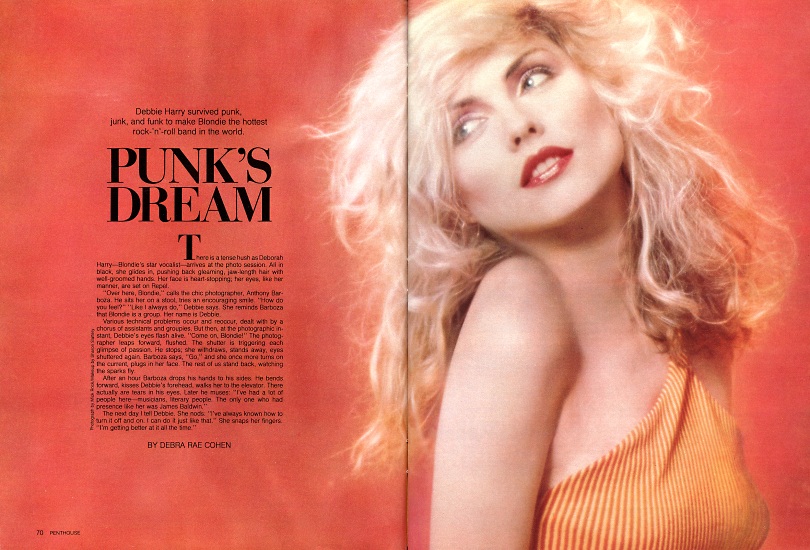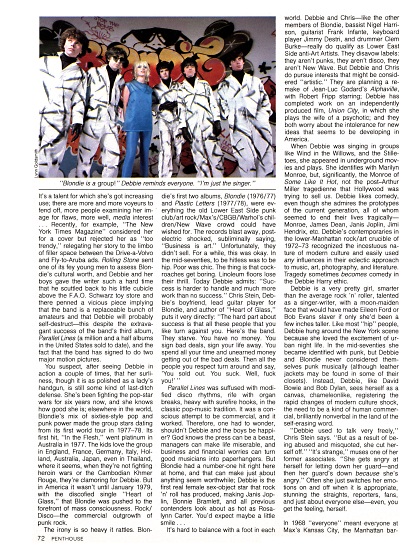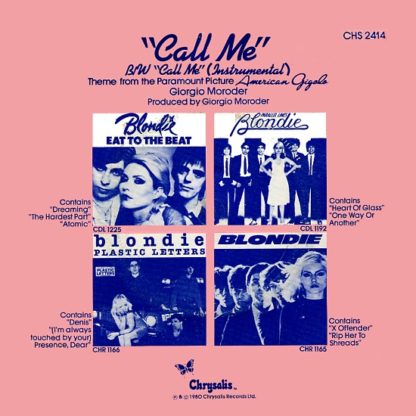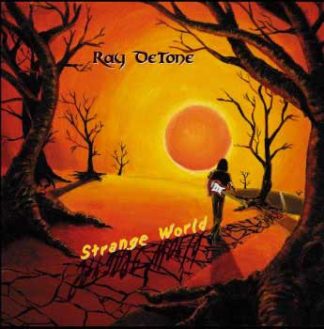Description
Blondie – Call Me
Label: Chrysalis
Catalog#: CHS 2414
Format: Vinyl, 7″
Country: UK
Released: 1980
Genre: Electronic Rock
Style: Synth-pop, Disco
Tracklist
A Call Me 3:30
B Call Me (Instrumental) 3:27
Producer – Giorgio Moroder
“Call Me” is a song by the American new wave band Blondie. Released in 1980, “Call Me” topped the singles charts in both the US (where it became the bands biggest selling single) and the UK (where it became their fourth no.1 hit).
The song was the main theme of the film American Gigolo. European disco producer Giorgio Moroder originally asked Stevie Nicks from Fleetwood Mac to help compose and perform a song for the soundtrack, but she declined. It was at this time that Moroder turned to Debbie Harry and Blondie. Moroder presented Harry with a rough instrumental track called “Man Machine.” Harry was asked to write the lyrics and melody, a process that Harry states took only a few hours. The completed song was then recorded by the band, with Moroder producing. The bridge of the original English language version also includes Harry singing “Call Me” in Italian (“Amore, chiamami”) and French (“Appelle-moi, mon cheri”).
The single was released in the United States in February 1980. It peaked at #1 for 6 weeks, and was certified Gold (for one million copies sold) by the RIAA. It also spent four weeks at number two on the U.S. dance chart. The single was also #1 on Billboard magazines 1980 year-end chart. It was released in the UK two months later, where it became Blondies fourth UK no.1 single in little over a year. The song was also played on a British Telecom advert from the 1980s. Twenty-five years after its original release, “Call Me” was ranked at #283 on the list of Rolling Stones 500 Greatest Songs of All Time.
The song lists at #44 on Billboards All Time Top 100
Call Me was a collaboration with Giorgio Moroder. The song was the theme to the Richard Gere film American Gigolo. Recording of the track took place in New York in August 1979.

Debbie Harry survived punk, junk, and funk to make Blondie the hottest rock-‘n’-roll band in the world.
PUNK’S
DREAM
BY DEBRA RAE COHEN
There is a tense hush as Deborah Harry – Blondie’s star vocalist – arrives at the photo session. All in black, she glides in, pushing back gleaming, jaw-length hair with well-groomed hands. Her face is heart-stopping; her eyes, like her manner, are set on Repel.
“Over here, Blondie,” calls the chic photographer, Anthony Barboza. He sits her on a stool, tries an encouraging smile. “How do you feel?” “Like I always do,” Debbie says. She reminds Barboza that Blondie is a group. Her name is Debbie.
Various technical problems occur and reoccur, dealt with by a chorus of assistants and groupies. But then, at the photographic instant, Debbie’s eyes flash alive. “Come on, Blondie!” The photographer leaps forward, flushed. The shutter is triggering each glimpse of passion. He stops; she withdraws, stands away, eyes shuttered again. Barboza says, “Go,” and she once more turns on the current, plugs in her face. The rest of us stand back, watching the sparks fly.
After an hour Barboza drops his hands to his sides. He bends forward, kisses Debbie’s forehead, walks her to the elevator. There actually are tears in his eyes. Later he muses: “I’ve had a lot of people here – musicians, literary people. The only one who had presence like her was James Baldwin.”
The next day I tell Debbie. She nods: “I’ve always known how to turn it off and on. I can do it just like that.” She snaps her fingers. “I’m getting better at it all the time.” It’s a talent for which she’s got increasing use; there are more and more voyeurs to fend off, more people examining her image for flaws, more well, media interest
… Recently, for example, “The New York Times Magazine” considered her for a cover but rejected her as “too trendy,” relegating her story to the limbo of filler space between the Drive-a-Volvo and Fly-to-Aruba ads. Rolling Stone sent one of its fey young men to assess Blondie’s cultural worth, and Debbie and her boys gave the writer such a hard time that he scuttled back to his little cubicle above the F.A.O. Schwarz toy store and there penned a vicious piece implying that the band is a replaceable bunch of amateurs and that Debbie will probably self-destruct – this despite the extravagant success of the band’s third album, Parallel Lines (a million and a half albums in the United States sold to date), and the fact that the band has signed to do two major motion pictures.
You suspect, after seeing Debbie in action a couple of times, that her surliness, though it is as polished as a lady’s handgun, is still some kind of last-ditch defense. She’s been fighting the pop-star wars for six years now, and she knows how good she is; elsewhere in the world, Blondie’s mix of sixties-style pop and punk power made the group stars dating from its first world tour in 1977-78. Its first hit, “In the Flesh,” went platinum in Australia in 1977. The kids love the group in England, France, Germany, Italy, Holland, Australia, Japan, even in Thailand, where it seems, when they’re not fighting heroin wars or the Cambodian Khmer Rouge, they’re clamoring for Debbie. But in America it wasn’t until January 1979, with the discofied single “Heart of Glass,” that Blondie was pushed to the forefront of mass consciousness. Rock/Disco – the commercial outgrowth of punk rock.

The irony is so heavy it rattles. Blondie’s first two albums, Blondie (1976/77) and Plastic Letters (1977/78), were everything the old Lower East Side punk club/art rock/Max’s/CBGB/Warhol’s children/New Wave crowd could have wished for. The records blast away, post-electric shocked, subliminally saying, “Business is art.” Unfortunately, they didn’t sell. For a while, this was okay. In the mid-seventies, to be hitless was to be hip. Poor was chic. The thing is that cockroaches get boring. Linoleum floors lose their thrill. Today Debbie admits: “Success is harder to handle and much more work than no success.” Chris Stein, Debbie’s boyfriend, lead guitar player for Blondie, and author of “Heart of Glass,” puts it very directly: “The hard part about success is that all  these people that you like turn against you. Here’s the band. They starve. You have no money. You sign bad deals, sign your life away. You spend all your time and unearned money getting out of the bad deals. Then all the people you respect turn around and say, ‘You sold out. You suck. Well, fuck you!’”
these people that you like turn against you. Here’s the band. They starve. You have no money. You sign bad deals, sign your life away. You spend all your time and unearned money getting out of the bad deals. Then all the people you respect turn around and say, ‘You sold out. You suck. Well, fuck you!’”

Parallel Lines was suffused with modified disco rhythms, rife with organ breaks, heavy with surefire hooks, in the classic pop-music tradition. It was a conscious attempt to be commercial, and it worked. Therefore, one had to wonder, shouldn’t Debbie and the boys be happier? God knows the press can be a beast, managers can make life miserable, and business and financial worries can turn good musicians into paper hangers. But Blondie had a number-one hit right here at home, and that can make just about anything seem worthwhile; Debbie is the first real female sex-object star that rock’n’roll has produced, making Janis Joplin, Bonnie Bramlett, and all previous contenders look about as hot as Rosalynn Carter. You’d expect maybe a little smile…
It’s hard to balance with a foot in each world. Debbie and Chris – like the other members of Blondie, bassist Nigel Harrison, guitarist Frank Infante, keyboard player Jimmy Destri, and drummer Clem Burke – really do qualify as Lower East Side anti-Art Artists. They disavow labels: they aren’t punks, they aren’t disco, they aren’t New Wave. But Debbie and Chris do pursue interests that might be considered “artistic.” They are planning a re-make of Jean-Luc Godard’s Alphaville, with Robert Fripp starring; Debbie has completed work on an independently produced film, Union City, in which she plays the wife of a psychotic; and they both worry about the intolerance for new ideas that seems to be developing in America.
When Debbie was singing in groups like Wind in the Willows, and the Stilletoes, she appeared in underground movies and plays. She identifies with Marilyn Monroe, but, significantly, the Monroe of Some Like It Hot, not the post-Arthur Miller tragedienne that Hollywood was trying to sell us. Debbie likes comedy, even though she admires the prototypes of the current generation, all of whom seemed to end their lives tragically – Monroe, James Dean, Janis Joplin, Jimi Hendrix, etc. Debbie’s contemporaries in the lower-Manhattan rock/art crucible of 1972-73 recognized the incestuous nature of modern culture and easily used any influences in their eclectic  approach to music, art, photography, and literature. Tragedy sometimes becomes comedy in the Debbie Harry ethic.
approach to music, art, photography, and literature. Tragedy sometimes becomes comedy in the Debbie Harry ethic.
Debbie is a very pretty girl, smarter than the average rock’n’roller, talented as a singer-writer, with a moon-maiden face that would have made Eileen Ford or Bob Evans slaver if only she’d been a few inches taller. Like most “hip” people, Debbie hung around the New York scene because she loved the excitement of urban night life. In the mid-seventies she became identified with punk, but Debbie and Blondie never considered themselves punk musically (although leather jackets may be found in some of their closets). Instead, Debbie, like David Bowie and Bob Dylan, sees herself as a canvas, chameleonlike, registering the rapid changes of modern culture shock, the need to be a kind of human commercial, brilliantly nonverbal in the land of the self-erasing word.
“Debbie used to talk very freely,” Chris Stein says. “But as a result of being abused and misquoted, she cut herself off.” “It’s strange,” muses one of her former associates. “She gets angry at herself for letting down her guard – and then her guard’s down because she’s angry.” Often she just switches her emotions on and off when it is appropriate, stunning the straights, reporters, fans, and just about everyone else – even, you get the feeling, herself.
In 1968 “everyone” meant everyone at Max’s Kansas City, the Manhattan bar-restaurant that was home for Andy Warhol’s painting and fashion crowd and a lot of musicians who thought rock was avant-garde art. Max’s was a mecca for young glamour-struck hangers-on. It had its own heady aura of heavy drugs, hard music, dark sex. It felt like Haiti in there, with Lou Reed prowling around in black shades at 2:00 A.M., his sleeves rolled down in the hottest weather, John Cale’s evil guitar chording on “I’m Waiting for the Man” or “Heroin” thundering like a soundtrack. Even the kids waiting tables were special, alive to the frenzy on the cutting edge of art – the desperate need to be famous. Upstairs the dining-room wall was an evolving exhibit with shifting, changing projected pictures, a photo-montage, a light show of sorts done with prisms and the faces of beautiful women and men, no two sequences alike. There were shots of boys and girls who worked at Max’s, boys and girls on the scene.
“Those were wild and crazy times.” Debbie Harry stares wide-eyed at an 007-style conference table as if watching someone lay out tarot cards. The slick Madison Avenue office of her press agents, The Press Office, is crowded with Kiss posters, press releases, Wings posters, promotional mailings – up-to-date music biz debris – but Harry is thinking back to the sixties, remembering. She shakes her head slightly: “It was fun being so naive and so young… to just stand around and look at Andy Warhol, Viva, Ultra Violet, Jane Fonda, James Coburn, Roger Vadim, the Jefferson Airplane, Janis Joplin, Jimi Hendrix, you name it. I’d be there every night and watch Alice Cooper go up and down. When I finished work, I’d go upstairs and dance my ass off. What a great time I had! What an education I got!”
For a while Debbie walked the exhilarating cliff edge of disaster; she drifted after her boyfriend into heroin use. She watched a lot of her playmates end up as drug casualties. Excess was the number at Max’s.
“I think that was when I really went crazy.” Debbie stares down at her hands in silence. “That’s when I was really weird. My boyfriend then was a drummer. He had been in the band for about a week. He was an unbelievable, high-caliber drummer, a drummer since he was three years old. He’s dead.” She clears her throat. Her voice has a husky catch in it. “He died,” she repeats. “But – it’s unbelievable – he taught me so much about music.” Eyes averted, she sweeps her hand across the table and lets it drop. “That’s another one gone.”
“That’s the thing about the sixties; there were all these tragedies. There are still these articles about 30-year-old  people that are – they call them survivors. I don’t want to be labeled as that, but in a certain respect…” Her voice trails off. “A lot of people died.”
people that are – they call them survivors. I don’t want to be labeled as that, but in a certain respect…” Her voice trails off. “A lot of people died.”
“Everybody was on drugs then,” says Ritty Dodge, who worked with Debbie at Max’s. “But nobody talked about it; everybody just got fried and partied all night. Debbie looked then, I thought, like a nice Polish girl – very corn-fed, with long, dirty-blonde hair. Everyone I knew loved her… but she was never one of the ones who passed out in the bathroom; she always showed up for work, kept it together, went home to her boyfriend. She just took up with the wrong person, and then she went on the skids; she had to have been a little naive, I think, a little out of her depth.”
She’s not any more: “I’m into Perrier water these days,” she says. “Everybody prints the drug stuff, but nobody talks about what a healthy girl I am now.” She grins like an ad for Synergy Plus Megavites: “I mean it.”
Hawthorne, N.J., is the kind of town where you always get stuck behind trucks marked Flammable. Harry was born in Miami to an unknown mother who put her up for adoption when she was three months old. Her foster parents – who now run a gift shop in Cooperstown, N.Y. – soon moved the family to Hawthorne, a nice suburb just across from the Paterson slums. The town is so nice that Hawthorne High’s had only one black graduate in its history. Except for a small “school sucks” graffito writ small on a pillar that holds the place up, Beaver Cleaver would find Hawthorne High quite congenial.
Not much has changed since 1963, when, identical but for the upsweep hairdo, Debbie Harry was voted the best-looking senior at Hawthorne High. When her little sister Martha got out, seven years later, senior girls wore black sweaters, with single, discreet strings of pearls. Debbie’s picture could have been taken one day last week; she looks not a day younger, no less aware. She even looks the same in the yearbook photo that catches her smiling, apple-cheeked, under a plumed cap, three embroidered majorette’s frogs on her chest. Look for a hellion, and you’ll be disappointed; 16 years ago they weren’t bred that way. At most, Debbie projected a gentle rebellion; she was an “introspective freak,” writing lyrics and folk songs for Frank Krueger’s English class, harboring secret “artistic” ideas. In the space for Ambition, right over her yearbook picture, Debbie wrote “Undecided” – a great sign of free thinking; most girls chose from a spectrum that ran from Mother to Nurse; their greatest desire was “To be a beautician and make my parents proud of me.”
Outside, Tom Nolan waves kids past him for fire drill lineup, pointing down the block with a sheaf of papers. Compact and natty in his aviator frames, he looks younger now than in his picture with Debbie’s Class of 1963. Twenty years in Hawthorne and Nolan still refers to the townspeople as “they.” “This is a very conservative place,” he confides as we walk back to the building. “I used to be known as ‘Tommy the Commie.’
“Let me tell you what it was like for kids who were ‘artistic.’ When Debbie’s class was here, the head of art was just about to retire; she’d taught for 52 years. Debbie’s junior dance was called ‘When in Rome.’ I remember, because they made all these decorations. One kid designed a beautiful, full-length silhouette of a girl – and this damn woman ruined it by making her put a dress on it! Made it look absolutely obscene.” He shakes his head in disbelief. “I couldn’t believe it.”
The sun glints off long formica tables in the cafeteria. Nolan is fending off dozens of wheedling kids begging for passes. Slightly more adult, with blue sweater and eye makeup, a pretty blonde is poised to cajole. “Mr. Nolan…” she begins; he turns to me swiftly “See that? That’s Debbie Harry when she was here.” The girl’s been anointed, but she’s not sure as what.
“Who’s she?” the blonde wants to know.
“She graduated from here. And then she went – ” Nolan stops. “To jail!”
The girl jumps back, wide-eyed.
“Only kidding,” he adds.




“I was destined to be an artist even then,” Debbie recalls deadpan. “I practiced putting on makeup a lot. I used to  study it carefully and practice everything.” She spreads out her hands, framing her moon-maiden face. “I used to sit in front of a mirror and try to make myself look Oriental. I made a lot of mistakes; sometimes I’d walk out of the house looking like a ghoul and not really know it. One time in eighth grade my mother wasn’t home; so I went upstairs and started fooling around. When I went back to school after lunch, no one would talk to me. Everybody went to one side of the lounge, and I was all by myself, practically in tears, with beauty marks all over my face.”
study it carefully and practice everything.” She spreads out her hands, framing her moon-maiden face. “I used to sit in front of a mirror and try to make myself look Oriental. I made a lot of mistakes; sometimes I’d walk out of the house looking like a ghoul and not really know it. One time in eighth grade my mother wasn’t home; so I went upstairs and started fooling around. When I went back to school after lunch, no one would talk to me. Everybody went to one side of the lounge, and I was all by myself, practically in tears, with beauty marks all over my face.”
Makeup served as admission to different personas. About this time Debbie began to be Blondie: “In high school I must have had ten or twelve different colors of hair. At first I would use a mix of peroxide and ammonia, stuff that was easy to get. I started with streaks, and then it gradually turned orange. That’s when my mother would start to notice. All of a sudden at dinner, she’d say, ‘Your hair is different. What did you do?’ And I’d just say, ‘Oh, I lightened it a little.’ My father would go – Debbie furrows her forehead and lets out a gruff bark – ‘Well, I don’t know if I like this, hmmm…’ But he liked it on my mother; so it was semiacceptable.” She grins at me conspiratorially. “Later it was turning up platinum.”
Hawthorne served as an out-of-town tryout. Debbie knew she’d end up in New York. She’s always had a built-in Geiger counter of hip, homing in on the center of the action. Method-acting in each new fashion, she was pretty enough to make each style convincing, whether hippie, folk-rocker, or punk, and too smart to type herself irrevocably.
Thinking back, she sits up uncomfortably straight, hands clasped before her; she shifts from side to side as if awaiting a test. Without makeup she looks not older but younger, a Peter Pan runaway, flawless under the harsh fluorescents. There’s a pout built into her upper lip. When she smiles, it’s incredible: her blue eyes narrow to slits, disappearing above the broadest cheekbones in showbiz; she’s prettier than Marilyn Monroe, though she acts as if she didn’t know it. She paints pictures with sounds more than with words; her voice works like a storyteller reading a child a bedtime tale – high-pitched little-girl tones and dumb-bunny accents alternate with strange, strangled chortles as sound-effect aids. It’s her clearest legacy from the punk ethic. “I have a really bad sense of where all the years are,” she murmurs. “It’s like lacking depth perception.”
Harry knew where to go, but it took a while to get there. Her parents prescribed a short stay, after high school, at Centenary College, a glorified finishing school. Debbie reached the East Village just as hippiedom dawned; her lip curls as she describes its transition to scuzz. “All these creeps hanging around on the street begging for money, doing numbers in the name of peace and love.”
Debbie spent some time with Wind in the Willows, a folkie-baroquey band. She met the members of the group through high-school friends. “It was a temporary association of convenience,” she says. The group put out one album in 1968, produced by Artie Kornfeld, later of Woodstock fame. Harry sang backup and played percussion.  Folk palled quickly for her. “I decided I wanted to do something harder, faster, and more exciting.” She left, she admits, with no thought-out alternative; the band broke up in her wake. Her homing device still working well, she found herself at Max’s during its heyday. Depression and drugs triggered a brief, disillusioning trip to California and a series of quick-money jobs in New York, including a stint as a Playboy Bunny. “It had always been one of my dreams,” Debbie says seriously. “I think it was because of this man that my mother and father knew, Mr. Whipple – like the commercial – except he was different, real handsome; I always had a big crush on him. He was a businessman who used to travel a lot, wild and exciting; he used to flirt with me a little, and I would diiie,” she drawls, “because he was so handsome. He was a Playboy subscriber and raved about the clubs – that was where I first heard about them. I always had it in the back of my mind. I did it for the money.
Folk palled quickly for her. “I decided I wanted to do something harder, faster, and more exciting.” She left, she admits, with no thought-out alternative; the band broke up in her wake. Her homing device still working well, she found herself at Max’s during its heyday. Depression and drugs triggered a brief, disillusioning trip to California and a series of quick-money jobs in New York, including a stint as a Playboy Bunny. “It had always been one of my dreams,” Debbie says seriously. “I think it was because of this man that my mother and father knew, Mr. Whipple – like the commercial – except he was different, real handsome; I always had a big crush on him. He was a businessman who used to travel a lot, wild and exciting; he used to flirt with me a little, and I would diiie,” she drawls, “because he was so handsome. He was a Playboy subscriber and raved about the clubs – that was where I first heard about them. I always had it in the back of my mind. I did it for the money.
“There were girls there who started their own businesses from what they made; girls were making from three to five hundred dollars a night. Cash! You had thirty-five people per show to wait on; sometimes you’d be carrying a double-stacked tray” – she half-rises, absorbed, and hefts an imaginary load – “this much liquor. A man watching a girl in a little costume with her tits hanging out, struggling with a tray among 500 people, he thinks, ‘Holy shit! How did she do that?’ It’s no big deal to give her a tip.”
Harry quit when the money became less important, when she marshaled her forces to end her three-year bout with drugs. “I got mad,” stresses Debbie. “I got bored. I guess I wasn’t that hopeless a case in the first place – luckily. A lot of things just clicked.”
Around this time Gil, her boyfriend, OD’d. Debbie’s hands are moving nervously; she twists a paper clip, pokes a hole in a coffee cup, ties the clip through the Styrofoam into a knot: “I died a couple of times, I think.” She speaks conversationally and doesn’t look up. “I think that’s what probably brought me back to life – having died. You know, just, actually, died. Physically, emotionally, spiritually. It really scared me.” Her matter-of-factness makes the words chilling.
“I wanted to learn self-hypnosis,” Debbie says. “I thought if I learned some kind of technique, a physical technique or a mental technique, that would be able to support me if I ever felt I needed to take drugs – so that I could get out of this rat race. But then I got into the psychoanalytic rat race – and that was another one!” Her voice rises shrilly. “I mean, that was taking as much time and money as the other thing had; so I had to get out of that, too.”
She lived in upstate New York and at home in New Jersey and stayed out of the city until she felt “cured.” She was finally lured back by the glittering advent of the New York Dolls. Omnisexual, celebratory, desperately vibrant, they rejuvenated the New York music scene as forerunners of the New Wave. They were more than the center of the action; they were closer to being a religion. People knew each other, they said, “from the Dolls.”
Debbie was still homing in on hip; it was another exciting new scene to embrace. “I was never a real groupie,” she cautions, “I was just a great fan.”
Ritty Dodge saw Debbie again down at Max’s in 1973, where the whole glitter was turning rococo. “She came in then, looking very extreme” – his voice fills with admiration – “wearing a brassiere and a half-slip to dance in and garish makeup like a whore’s. She was really ahead of her time.” Says Elda Gentile, who hung out with Doll Syl Sylvain, “She used to come by in her little blue car from New Jersey, ride around with us, and party with the boys.”
 When Elda’s glitz band, Pure Garbage, broke up in 1973, Debbie, anxious to get back to performing, joined up to help form a new act – the three-girl Stilletoes, with a theme, Debbie says, “like the visual effect of True Confessions or Modern Romance.” “The best song,” says Elda, “was called ‘Dracula, What Did You Do to My Mother?’ We wore green crosses and skull eyeglasses that we bought on Forty-second Street. It was great.
When Elda’s glitz band, Pure Garbage, broke up in 1973, Debbie, anxious to get back to performing, joined up to help form a new act – the three-girl Stilletoes, with a theme, Debbie says, “like the visual effect of True Confessions or Modern Romance.” “The best song,” says Elda, “was called ‘Dracula, What Did You Do to My Mother?’ We wore green crosses and skull eyeglasses that we bought on Forty-second Street. It was great.
“We played at the Boburn Tavern on Twenty-eighth Street; it was just a tiny, shitty little dive where they took the legs off the pool table to use it as a stage. We didn’t think we’d get much of a crowd, but the place was jammed; by the next week, David Bowie and Angie were pulling up in their limousine. We had New York by the balls,” she laughs. “There was nothing going on in those days.”
Eric Emmerson – now dead, who knew Debbie from her waitress days at Max’s – was one of Elda’s “husbands,” and one day he brought his guitarist-roommate Chris Stein to watch the Stilletoes act. Chris’s eyes met Debbie’s across the room; they’ve been personally and professionally inseparable ever since.
When Elda speaks of Harry, her voice chimes with knew-her-when bitterness. “She used to make me swear to God that I’d never tell anybody she sang with that other band, Wind in the Willows. I didn’t know about it until months after we started working together. It was a very hard-rock thing that was going on then, and anything that seemed to be going against it – I think she was afraid people might be turned off. She wrote pretty lyrics – like “In the Flesh” – that she had no faith in. She was so unconfident; we’d go, ‘Come on, this is beautiful,’ but she wouldn’t admit it. I’m very hard-edged, but she had a softness, a bubbliness that she just pushed down.”
Push, as it so often does, came to shove: the band had a falling-out, and bassist Fred (ex-Television member now with the Richard Lloyd Band) Smith and drummer Billy O’Connor followed Debbie and Chris. They played around as Angel, Snake, and finally Blondie. For backup they added the Banzai Babies, the Bellomo sisters, Snookie and Tish, whose resumes read like a name-that-punk baby book. “I met them,” says Debbie, “through these guys Gorilla and Tomato; Tomato now has a group called the Screamers, and Gorilla is Gorilla Rose; he writes songs. But they used to do comedy skits at CBGB (the original New York punk club, on the Bowery), things like Babs the Stunt Girl or Savage Voodoo Nuns. Tish and Snookie were in some of the crazier shows.”
Now the Bellomos run Manic Panic, the punk fashion boutique on St. Mark’s Place. The walls sport hundreds of bright, spike-heeled shoes – one shoe from each pair hanging in each of two rooms. The sisters clear spaces between piles of clothing. “Debbie decided we should be a disco dance band,” recalls ponytailed Snookie. “She got us a job playing Brandy’s Too, an Upper East Side singles place, two long sets a night.” They ponder, and “Heart of Glass,” comes on the radio. Trading lines, the sisters complete each other’s sentences: “The crowd was half friends, who came up to hang out, and half the sleazy singles crowd. They didn’t understand a thing, missed lots of the lyrics – like one song that we did called ‘Funky Anus.’” The three girls wore glitter, cavewoman outfits, 1950s party dresses with bathing suits underneath. Blondie tried to pass good fortune on to its friends: “The Ramones came to open for us,” says Tish, pulling the ends of her punk-purple shag, “but they started out with ‘Sniffin’ Glue,’ and the management asked them to leave. The Tuff Darts walked out in a huff when management told ’em they were too loud.”
Blondie, meanwhile, was having its own problems. Fred Smith left to join Television, and, says Tish, “our drummer kept falling asleep all the time.” Clem Burke took his place, winning out by audition. The beleaguered Bellomos say they were dropped without a word. Gary Valentine was on bass (he has since been replaced by Nigel Harrison), and keyboard whiz Jimmy Destri completed the band. Blondie became the new hot group on the small-club circuit. The band boasted cartoon sensibilities, tongues firmly in cheek, kick-ass musicianship, and historical perspective, plus a singer who looked like a 14-year-old’s wet dream. Leaping and strutting in punkette tight-leopard-skin pants, Debbie projected a sort of sensual klutziness. “I didn’t have much control over anything except singing,” she says sheepishly, “and some people wondered about that.”
One who wondered was Larry Uttal, president of Private Stock Records, who signed Blondie in 1976 at the urging of Richie Gottehrer, a British producer who was nuts about Debbie Harry’s potential. Richie got Blondie to do a single “X Offender,” on Uttal’s label and then the band’s first two albums, none of which sold. Uttal and Gottehrer pressured the band to hire a skinny operator called Peter Leeds as manager. A year later Leeds, claiming that Uttal wasn’t giving him enough money to push the group and that Uttal had “hurt” Blondie by hustling a “sleazy” poster showing Blondie in a see-through trash outfit, signed the group with Chrysalis, a British-based outfit known for its quality acts. At Chrysalis wizard producer Mike Chapman was signed to handle Blondie. Leeds claims credit for this. So does Terry Ellis, a Chrysalis owner. In an case, Chapman was the best choice on earth, as all the gold and platinum records Parallel Lines earned proves. As soon as the album hit, Debbie and Stein began pushing Leeds out. After months of dark threats, in which they “auditioned” new managers, including Bill Graham and Shep Gordon, they chose Gordon, manager of Alice Cooper and Teddy Prendergast, among others. Gordon took over on August 1, 1979, and the official word is Total Happiness for everyone, although the group allegedly had to give up a large part of its future gross plus more than a quarter of a million dollars to lose Leeds.
Center stage at New York’s Palladium. Debbie stretches, her black bodysuit ripples, glowing. Behind me, a teenager wearing an Iggy T-shirt groans with violent, strained delight. Debbie Harry can inspire odd excesses. At concert’s end I see a kid punching his crotch in wild frustration. Scary, I think, and somewhat sinister, the idea of holding that kind of sway. But it doesn’t bother Harry; she’s always been a golden girl. Why tamper with success?
“I think that the highest appreciation that anyone has is usually sexual,” she protests. “Just as a girl, as a female, would that bother you?”
“Yes, I admit, if it obscured more important things.”
“But that is the important thing!” She’s wide-eyed, sincere. “It really is. Because sex is the biggest seller – sells more magazines, more clothes, more everything. Sex is it. In rock’n’roll,” she adds, “it’s sex and sass.” She curls her lip, narrows her eyes, and throws out a hip with a defiant fuck-you gesture.
“That ‘Ahh, I don’t care, I don’t give a fuck’ – that’s a very heavy attitude,” Debbie continues. She seems to be talking to herself, thinking out loud. I say, somewhat lamely. “What else sells?”
Debbie ponders a moment, scrunching up her face like a little girl. “Nothing.”
And, as if in illustration, Blondie’s records have become more successful as Harry’s stage sexuality has gone through a change. No more tiger-striped mini-skirts, like leftover Stilletoes outfits; she’s moving inexorably toward straightforward, grown-up glamour – less kitsch, more class, to match her improved, slicker singing. It gives her more space for seduction in earnest. “I think I’m more outrageous now,” she ventures. “I always thought I was really conservative, shy, trying to feel my way around. Now I’m really loose. Maybe it’s a matter of giving up control, like one of those Zen moot points; I think I’m more sexual, but in a less calculated way.”
It’s a way of growing up, picking the costume that works; at 34-plus, Debbie Harry’s finally a postadolescent. “There was a time in my life,” she says softly, “when I was very, very depressed. And all through it I wished I had someone, like, older, to come tell me what to do, give me some hints. But I didn’t have that; I was all on my own.”
If she’s secure now, it’s due largely to Chris. They’re part coworkers, part lovers, part Svengali-and-muse; he bolstered her resolve, refined her ambitions, and defended her honor by attacking the press. Quick and verbal, he annexes – even preempts – conversations, grating and ingratiating by turns; his is the float-like-a-butterfly-sting-like-a-bee approach to the media. Chris knows that the media’s there to be utilized. He’s concerned with a platform to billboard his views. The only way to get a fair deal is to stack the deck yourself. Debbie looks to him for cues and me-toos his arguments. I’m struck by the difference in her, with and without him. Less spontaneous, more self-assured, she goes farther out on the limb he selects. It’s part of being a nice girl from New Jersey; you find – and defer to – a nice boy to depend on.
Eating lunch at 4:00 P.M., Debbie picks at what looks like a plateful of catsup and babbles, gleeful as a bride. “Whatever we live,” she says with mock horror, “incredible tragedy seems to dog our footsteps. We lived in SoHo when it was still Little Italy [“Moved out before it got fashionable,” Chris interjects], and we got completely cleaned out. Then we lived in a loft on the Bowery – the heater was all fucked up. We woke up every morning with our faces covered with soot. Then on Seventeenth Street – what?” She looks at Stein. “Oh, we had a fire and lost everything. Then we lived in hotels for a year, and that was okay. So far where we are now (a Sixth Avenue penthouse) everything is alright.”
The showroom is crowded with lucite constructions, bulbous bronze cherubs holding up lampshades, coffee tables of indeterminate metal and gut-wrenching asymmetry. Chris and Debbie are shopping for furniture, cut-rate. Salesman Sid Cohen smiles indulgently at the raffish young couple – the boy with his Ralph Lauren horn-rims askew, the blonde in leopard-trimmed shoes and a red hooded sweatshirt – flipping through photos of modular furniture. It’s an obvious case of First Major Purchase.
Sid decides to do them a favor. “Do you like what you’re sitting on? I have a $1,000 deposit and a customer in jail – six hundred dollars and its yours.”
In an automatic gesture their hands smooth the fabric – hopelessly garish, the mid-air collision of two colored kites. They signal, regretfully, gratefully, no. The young man rejects another design: “Too much like airport furniture.”
“Oh,” ventures Sid, “do you travel a lot?” The girl nods emphatically, with a shy, friendly smile, and tucks white-blonde strands behind her ears.
“Are you in a group?”
“Uh-huh,” says Debbie.
“Which one,” asks Sid.
“Blondie,” says Debbie.
“Why?” asks Sid, with forced chuckle.
“Use your imagination,” says Debbie, her voice veering toward the tone she used on the photographer.
Slouched forward, Chris begins a chatty commercial. “We have a song that’s done very well; maybe you’ve heard it. It’s called ‘Heart of Glass’!”
Distracted, Sid smooths back his straight, graying hair. He fingers his pinky ring and stares at the table. “My daughter wants to be a singer, but I haven’t encouraged her…” His voice trails off.
“But you have to!” Debbie cries, leaning forward. Suddenly she’s straight-backed and earnest, all her hostility vanished. “It’s very important. You have to encourage her!”
The title comes up in gleaming white cursive letters, looking like the old ’50s Chevrolet logo, as an ominous synthetic drone rings out on the soundtrack. That drone gets louder and louder, and then there’s an itchy drumroll, like an engine working to turn over. Suddenly, we cut to an image — the spinning wheel of a black Mercedes, flying down a California highway — just as the guitar comes crashing in. A young and impossibly handsome Richard Gere is driving that convertible, his hair blowing in the wind, his face frozen and impassive. He’s got on a designer suit, and he barely looks human. Debbie Harry screams and snarls and coos, and we watch as Gere cooly shops for even more expensive clothes, flirts with a saleswoman, kisses the neck of a fur-coated woman. It’s all just so glamorous.
This is the opening of American Gigolo, the 1980 film from Taxi Driver screenwriter Paul Schrader. Schrader was, and is, a misanthropist to the core, and this fashionable facade will turn out to be a thin shell. Gere’s character is a male hustler. We’ll see him beaten and bedraggled, framed for murder and fighting for his life. Schrader only establishes this glamorous image to break it down, to reduce it to atoms. And yet those first few frames are what we remember. They, and the song that accompanies them, will linger.
By 1980, Giorgio Moroder had conquered pop music, helping transform his longtime collaborator Donna Summer into the biggest star of disco’s final boom period. He’d also begun to change the way Hollywood sounded. Moroder scored Midnight Express, his first film, in 1978, and he won an Oscar for it. Moroder’s sound, chilly and distant and futuristic, resembled nothing else in pop music or in film. He was a natural to score American Gigolo, the story of this blank-faced sex worker getting in over his head. The project would lead Moroder to years of collaboration with the young producer Jerry Bruckheimer, the former ad executive who would quickly perfect a very ’80s blockbuster aesthetic.
We can see that aesthetic at work in that opening scene. Moroder had composed the score, a hard-pulsing disco-rock thump not too distant from what he’d done with Donna Summer on the Bad Girls album. Moroder’s years of collaboration with Summer were winding down by 1980, and he figured that this opening number should be a rock song. Moroder wanted Stevie Nicks to sing the opening number, but Nicks’ contract wouldn’t allow her to work with Moroder. So Moroder turned to Debbie Harry, the leader of the New York punk band whose first #1 single had been a loose attempt at Moroder’s detached disco depravity.
A year earlier, Blondie had hit #1 with “Heart Of Glass,” a shimmering blank-faced quasi-disco jam. Neither Blondie nor producer Mike Chapman had any idea how to make Moroder-style disco, so they essentially taught themselves, and they wound up making something unforgettable. “Heart Of Glass,” had been Blondie’s first Billboard Hot 100 hit, and it made them into stars. But Blondie’s follow-ups were only minor hits. (“One Way Or Another” peaked at #24. “Sunday Girl” peaked at #27.) It would take a team-up with a real disco master to bring Blondie back to the top.
“Call Me” is Moroder’s American Gigolo score transformed into a pop song, something Moroder knew how to accomplish. The first time Debbie Harry heard that music, she was at Paul Schrader’s hotel, watching a rough cut of American Gigolo on video. Immediately thereafter, Harry went home and wrote the lyrics to “Call Me.” She was writing from the perspective of the Richard Gere character — always on call and available for love, at a price.
Harry has never sounded more like a straight-up rocker than she does on “Call Me.” Where she’d sung “Heart Of Glass” as an icy flirt, she became a snarling, wailing human id on “Call Me.” She belts the sound out with a feverish sense of devotion, but she’s not looking for love. She’s looking for money. “Roll me in designer sheets,” she pleads. “I never get enough.” On the second verse, she demands that a customer call her in Italian, and then in French. In the definitive extended eight-minute version of “Call Me,” from the American Gigolo soundtrack album, she demands, “Take me out and show me off and put me on the scene/ Dress me in the fashion of the 1980s.” The single came out exactly 32 days into the new decade. Debbie Harry could just tell.
The other members of Blondie don’t have a whole lot to do with “Call Me,” though we shouldn’t discount the boys in the band all yelling the title phrase on the chorus. Harry could’ve released it as a solo track. It’s a clear collaboration between Moroder and Harry, one that finds an ideal midway point between their sounds. The track is sleek and efficient, a mechanistic marvel. It hurtles forward, and yet Moroder weaves bittersweet synth melodies into all the bombast. But there are also feverish guitar-fuzzbombs everywhere, and Harry goes full werewolf, cranking her intensity up all the way. “Call Me” isn’t disco, and it damn sure isn’t punk. It’s the next thing. It whips you along into the sleazy neon future.
American Gigolo was a mild success upon arrival, but “Call Me” turned out to be the real star of the movie. The song became the year’s biggest single. It fully established Blondie as chart dominators, and it announced Moroder as someone who could thrive in the period after disco, especially when his sounds were paired with Hollywood imagery. It’s an immaculately designed work of engineering — an ideal pairing of European precision and American muscle. There was talk of Blondie recording a whole album with Moroder after the single’s success, but Moroder found working with the band too messy. That album could’ve probably been amazing, but no matter. Blondie and Moroder will both appear in this column again.
BONUS BEATS: Previous chart-toppers Alvin & The Chipmunks covered “Call Me” on their 1980 album Chipmunk Punk. (If you think about it, Alvin promising “sweet delight” really foreshadows that whole Richard Gere gerbil urban legend.) Here’s that:
BONUS BONUS BEATS: Here’s Debbie Harry performing “Call Me” on a 1981 episode of The Muppet Show:
BONUS BONUS BONUS BEATS: Here’s the scene in the 1998 film Bride Of Chucky where the bride of Chucky gets all primped up while “Call Me” plays on the soundtrack:
BONUS BONUS BONUS BONUS BEATS: Here’s some extremely shaky footage of No Doubt covering “Call Me” with Garbage’s Shirley Manson and the Distillers’ Brody Dalle at a 2002 show in Long Beach:
(No Doubt’s highest-charting single, the 2002 Ivy Queen collaboration “Underneath It All,” peaked at #3; it’s an 8. As a solo artist, No Doubt’s Gwen Stefani will eventually appear in this column. Garbage have never had a top-10 US hit; their highest-charting single, 1996’s excellent “Stupid Girl,” peaked at #24.)
BONUS BONUS BONUS BONUS BONUS BEATS: Here’s the Dandy Warhols’ 2003 cover of “Call Me,” included as a B-side on their “We Used To Be Friends” single










![LOST PROPHETS: Thefakesoundofprogress CD [Gold album in the UK, Nu Metal success]](https://yperano.com/wp-content/uploads/2016/03/18024-LOST-PROPHETS-Thefakesoundofprogress-CD-Gold-album-in-the-UK-Nu-Metal-success.jpg)

![DESTINY: The Tracy Chapter CD [modern hardcore Metal]](https://yperano.com/wp-content/uploads/2016/03/18321-DESTINY-The-Tracy-Chapter-CD-modern-hardcore-Metal.jpg)



Reviews
There are no reviews yet.